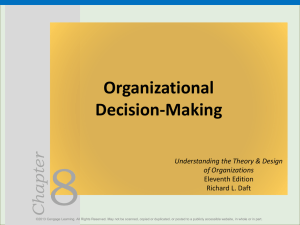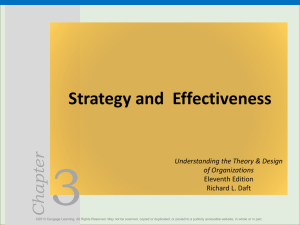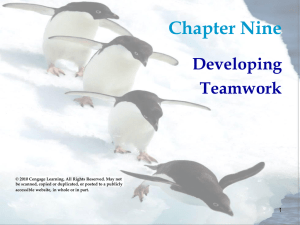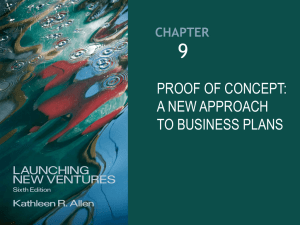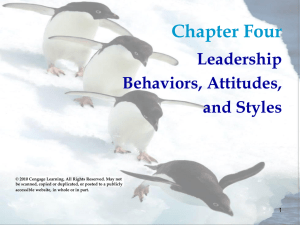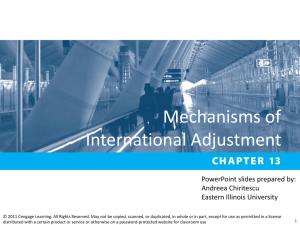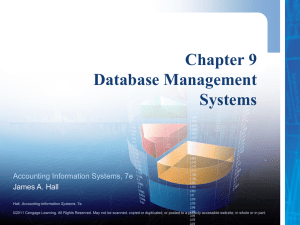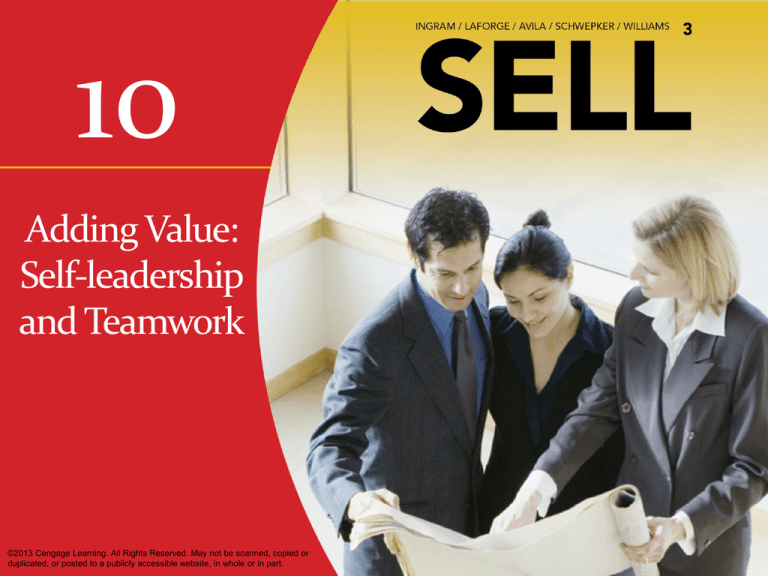
10
Adding Value:
Self-leadership
and Teamwork
©2013 Cengage Learning. All Rights Reserved. May not be scanned, copied or
duplicated, or posted to a publicly accessible website, in whole or in part.
Learning Objectives
L 1 Explain the five sequential steps of
self-leadership.
L
Identify the four levels of sales goals and
2 explain their interrelationships.
L
Describe two techniques for account
3 classification.
©2013 Cengage Learning. All Rights Reserved. May not be scanned, copied or duplicated, or posted to a publicly accessible website, in whole or in part.
10
Learning Objectives
L
Explain the application of different
4 territory routing techniques.
L
Interpret the usefulness of different types
5 of selling technology and automation.
L 6 Delineate six skills for building internal
relationships and teams.
©2013 Cengage Learning. All Rights Reserved. May not be scanned, copied or duplicated, or posted to a publicly accessible website, in whole or in part.
10
Key Thoughts
• Self-leadership is “mission-critical” for salespeople
because of the independent nature of most sales
jobs.
• Learning how to establish goals is an important
component of self-leadership.
• Some customers are a resource drain. The trick is to
separate out those with potential for growth
from those without it.
• Successful salespeople leverage
technology to help them work
smarter not harder.
©2013 Cengage Learning. All Rights Reserved. May not be scanned, copied or duplicated, or posted to a publicly accessible website, in whole or in part.
10
10
Q. 1. Define Self-Leadership.
©2013 Cengage Learning. All Rights Reserved. May not be scanned, copied or duplicated, or posted to a publicly accessible website, in whole or in part.
Self-Leadership
The process of doing the right things and doing them well. It
includes the strategic application of effort that is honed and aligned
with one’s goals.
©2013 Cengage Learning. All Rights Reserved. May not be scanned, copied or duplicated, or posted to a publicly accessible website, in whole or in part.
10
10
Q. 2. What are the five sequential stages
of self-leadership?
©2013 Cengage Learning. All Rights Reserved. May not be scanned, copied or duplicated, or posted to a publicly accessible website, in whole or in part.
5 Sequential Stages of Self-Leadership
Assessment & evaluation
10
Setting goals & objectives
Tapping technology
& automation
Territory analysis &
account classification
Development & implementation
of strategies & plans
©2013 Cengage Learning. All Rights Reserved. May not be scanned, copied or duplicated, or posted to a publicly accessible website, in whole or in part.
Understanding Goals
Effective goals and objectives must possess
three fundamental characteristics
©2013 Cengage Learning. All Rights Reserved. May not be scanned, copied or duplicated, or posted to a publicly accessible website, in whole or in part.
10
Different Levels & Types of Goals
•
•
•
•
Personal Goals
Territory Goals
Account Goals
Sales Call Goals
©2013 Cengage Learning. All Rights Reserved. May not be scanned, copied or duplicated, or posted to a publicly accessible website, in whole or in part.
10
Different Levels & Types of Goals
©2013 Cengage Learning. All Rights Reserved. May not be scanned, copied or duplicated, or posted to a publicly accessible website, in whole or in part.
10
Stage 1 – Setting Goals (Example)
©2013 Cengage Learning. All Rights Reserved. May not be scanned, copied or duplicated, or posted to a publicly accessible website, in whole or in part.
10
Common Types of Sales Goals
©2013 Cengage Learning. All Rights Reserved. May not be scanned, copied or duplicated, or posted to a publicly accessible website, in whole or in part.
10
Territory Analysis
The process of
surveying an area
to determine
customers and
prospects who
are most likely to
buy.
©2013 Cengage Learning. All Rights Reserved. May not be scanned, copied or duplicated, or posted to a publicly accessible website, in whole or in part.
10
Stage Two: Territory Analysis
and Account Classification
•
•
•
•
Who are prospective buyers?
Where are they located?
What and why do they buy?
Who has the authority to
buy, who influences the
buying decision?
• What is the probability
of selling this account?
• What is the potential
share of account that might
be gained?
©2013 Cengage Learning. All Rights Reserved. May not be scanned, copied or duplicated, or posted to a publicly accessible website, in whole or in part.
10
10
Q. 3. What are the different types of
account classifications?
©2013 Cengage Learning. All Rights Reserved. May not be scanned, copied or duplicated, or posted to a publicly accessible website, in whole or in part.
Stage Two: Territory Analysis
and Account Classification
©2013 Cengage Learning. All Rights Reserved. May not be scanned, copied or duplicated, or posted to a publicly accessible website, in whole or in part.
10
Account Classification – Single Factor
©2013 Cengage Learning. All Rights Reserved. May not be scanned, copied or duplicated, or posted to a publicly accessible website, in whole or in part.
10
Account Classification - Portfolio
©2013 Cengage Learning. All Rights Reserved. May not be scanned, copied or duplicated, or posted to a publicly accessible website, in whole or in part.
10
Portfolio Method - Example
Strong
Weak
High
Attractive, deserve
significant investment of
resources
Potentially Attractive,
Strengthen Competitive
Advantage before significant
investment
Low
Account Opportunity
Competitive Position
Moderately attractive, but
growth potential is low,
moderate investment of
resources
Unattractive, deserves
minimal investment of
resources
©2013 Cengage Learning. All Rights Reserved. May not be scanned, copied or duplicated, or posted to a publicly accessible website, in whole or in part.
10
Stage 3 – Development &
Implementation of Strategies & Plans
Establish and Implement Selling Task and Activity
Plans (e.g., sales goals, expense budgets, number of new
accounts, and so forth)
–
–
–
–
Yearly plan (sales goals and expensed budgets)
Quarterly Plan
Monthly Plan
Weekly Plan
Note: Yearly plan should support
the goals of the organization.
Quarterly, Monthly, and Weekly
plans should support the yearly
plan.
Execution of plans should be monitored and
adjustments made as necessary.
©2013 Cengage Learning. All Rights Reserved. May not be scanned, copied or duplicated, or posted to a publicly accessible website, in whole or in part.
10
Establishing Territory Routing Plans
Types of Territory Route Patterns
©2013 Cengage Learning. All Rights Reserved. May not be scanned, copied or duplicated, or posted to a publicly accessible website, in whole or in part.
10
10
Q. 4. What are the five common routing
plans?
©2013 Cengage Learning. All Rights Reserved. May not be scanned, copied or duplicated, or posted to a publicly accessible website, in whole or in part.
Straight-Line Route Pattern
Works Best When:
Accounts are located in
clusters that are some
distance from one another.
©2013 Cengage Learning. All Rights Reserved. May not be scanned, copied or duplicated, or posted to a publicly accessible website, in whole or in part.
10
Cloverleaf Route Pattern
Works Best When:
Accounts are concentrated in
different parts of the territory.
©2013 Cengage Learning. All Rights Reserved. May not be scanned, copied or duplicated, or posted to a publicly accessible website, in whole or in part.
10
Circular Route Pattern
Works Best When:
Accounts evenly dispersed
throughout the territory.
©2013 Cengage Learning. All Rights Reserved. May not be scanned, copied or duplicated, or posted to a publicly accessible website, in whole or in part.
10
Leapfrog Route Pattern
Works Best
When:
Territory is large
and accounts are
clustered into
several widely
dispersed groups.
©2013 Cengage Learning. All Rights Reserved. May not be scanned, copied or duplicated, or posted to a publicly accessible website, in whole or in part.
10
Major-City Route Pattern
Works Best When:
Territory is
composed of major
metropolitan areas.
©2013 Cengage Learning. All Rights Reserved. May not be scanned, copied or duplicated, or posted to a publicly accessible website, in whole or in part.
10
Mobile Sales Technology
Portable Computers and Smartphones
–
–
–
–
Mobile CRM applications
Presentation Capabilities
E-mail, texting, Social Networking
Wireless Communications
Deal Analytics
– “Smart” sales force automation
tools that analyze data on past
customer behavior, cross-selling
opportunities, and demographics to identify
areas of opportunity and high customer interest.
©2013 Cengage Learning. All Rights Reserved. May not be scanned, copied or duplicated, or posted to a publicly accessible website, in whole or in part.
10
Internet/Word Wide Web
• Internet
• Intranets (controlled corporate
access)
• Extranets (controlled access to
customers and suppliers)
• Wi-Fi Connectivity
– Hot Spots
– Mobile Wi-Fi Access (Mi-Fi)
©2013 Cengage Learning. All Rights Reserved. May not be scanned, copied or duplicated, or posted to a publicly accessible website, in whole or in part.
10
Ethical Dilemma
©2013 Cengage Learning. All Rights Reserved. May not be scanned, copied or duplicated, or posted to a publicly accessible website, in whole or in part.
10
Stage 5 – Assessment of
Performance and Goal Attainment
• Plan for periodic checkpoints.
• Compare projected performance level
to actual performance level.
• Evaluate performance
and make adjustments
as necessary.
©2013 Cengage Learning. All Rights Reserved. May not be scanned, copied or duplicated, or posted to a publicly accessible website, in whole or in part.
10
Increasing Customer Value
Through Teamwork
•
•
•
•
Internal and External Relationships
Sales Partnerships
Marketing Partnerships
Design and Manufacturing
Partnerships
• Administrative Support
Partnerships
• Shipping and Transportation
Partnerships
• Customer Service Partnerships
©2013 Cengage Learning. All Rights Reserved. May not be scanned, copied or duplicated, or posted to a publicly accessible website, in whole or in part.
10
10
Q. 5. What are the six teamwork skills that
salespeople should know?
©2013 Cengage Learning. All Rights Reserved. May not be scanned, copied or duplicated, or posted to a publicly accessible website, in whole or in part.
Building Teamwork Skills
• Understanding the Other Individuals
• Attending to the Little
Things
• Keeping Commitments
• Clarifying Expectations
• Showing Personal
Integrity
• Apologizing Sincerely When
a Mistake Is Made
©2013 Cengage Learning. All Rights Reserved. May not be scanned, copied or duplicated, or posted to a publicly accessible website, in whole or in part.
10
Ethical Dilemma
©2013 Cengage Learning. All Rights Reserved. May not be scanned, copied or duplicated, or posted to a publicly accessible website, in whole or in part.
10
Relationship of Optimized
Solutions, Trust, and Cooperation
High
Mutual Trust
Optimized &
Synergistic Solutions
(Win/Win)
Compromise
Solutions
Competitive &
Defensive Outcomes
(Win/Lose or Lose/Win)
Low
Low
Mutual Cooperation
High
©2013 Cengage Learning. All Rights Reserved. May not be scanned, copied or duplicated, or posted to a publicly accessible website, in whole or in part.
10


